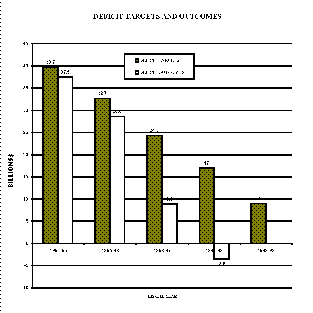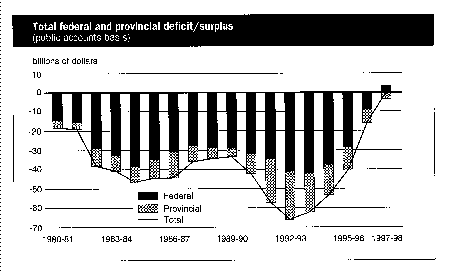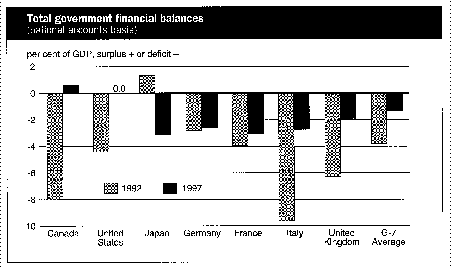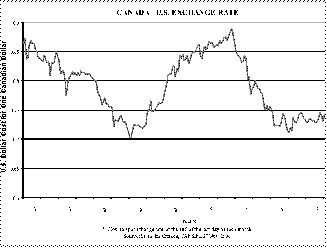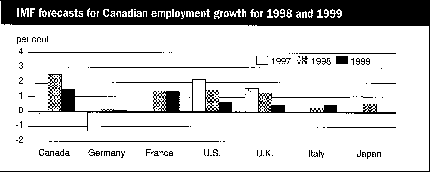FINA Committee Report
If you have any questions or comments regarding the accessibility of this publication, please contact us at accessible@parl.gc.ca.
CHAPTER 1: A NEW ERA EMERGES
In 1997-98, the federal government, for the first time since 1969-70, ended a fiscal year without recording a budgetary deficit. It predicted a zero deficit, after taking into account a $3 billion contingency reserve. With the books now closed, the final tally was a surplus of $3.5 billion.
I am pleased to announce that, for the first time in more than a generation, the Government of Canada has recorded a surplus - $3.5 billion. That money has been applied directly to the debt. This marks the first time in 28 years that Canada has actually paid down the debt.
Paul Martin, The Economic and Fiscal Update, October 14, 1998.
As in the past, the federal government has once again bettered its original target by a substantial margin. The deficit target for the fiscal year 1997-98 was originally set at 2% of GDP, approximately $17 billion. In sheer dollar terms, this result is even more dramatic than that achieved in the previous year, when the deficit was $8.9 billion instead of the $24.3 billion targeted.
The improvement in the federal budgetary balance is the most dramatic turnaround in federal government finances since the Second World War demobilization
The Economic and Fiscal Update, October 14, 1998.
Source: Department of Finance data.
Last year, the Committee spoke about entering a new era. Clearly, with the first balanced federal budget in almost 30 years, that era has begun. However, the question of what this new reality means remains unanswered. With repeated success on the fiscal front, many optimistic forecasts have been made about the size of the fiscal dividend, and many have proposed ways of using these new resources. But economic events suggest that caution continues to be the best approach. Expectations about new programs should not be raised so high that Canadians are most disappointed when we in fact achieve our greatest fiscal goals, namely the end of deficit financing and a reduction in government debt.
We strongly support setting a high priority on reducing Canada's indebtedness. The reason for that is we believe that the level of indebtedness that remains, while it is a great improvement and has certainly helped us in the recent period of instability is still too high, so Canada is still vulnerable to perturbations from outside this country...
Jean Van Loon (President, Canadian Steel Producers' Association, CSPA)
Despite the importance of continued caution, our recent successes indicate that we should look to the future with optimism. Challenges provide us with opportunities as well as obstacles. If we are to create a competitive economy, one that satisfies the needs and aspirations of Canadians, we need to seize these opportunities. Continued fiscal responsibility will help us do that.
Source: Economic and Fiscal Update, October 14, 1998.
Canada was the only one of the G-7 nations to register a surplus in 1997, almost 1% of GDP for the total government sector, when measured on a national accounts basis. This is in sharp contrast to 1992, when we registered deficits equal to 8% of GDP, the second worst record next to Italy. This fiscal improvement was the most dramatic of all the G-7 nations.
The budgetary surplus means that the net public debt fell from $583.2 billion in 1996-97 to $579.7 billion in 1997-98 - the first decline in the absolute level of the net public debt since 1969-70.
This was largely achieved because of the substantial drop in program spending by all levels of government. From 41.7% of GDP in 1992, to 33.8% of GDP in 1997, this represented a decline of over 19%. The provinces have also contributed significantly to this trend, with program spending as a percentage of GDP falling by about the same magnitude.
The federal budget balance has improved from a deficit of $42 billion in 1993-94 to a surplus of $3.5 billion in 1997-98.
Both levels of government in Canada have turned around their fiscal positions substantially. The debt-to-GDP ratio is now declining at both the federal and the provincial and territorial levels. The very obvious benefit of this turnaround can be seen in the decline in the interest burden. Debt charges, which were consuming more than 35 cents of every dollar of federal revenue in 1995-96, are now taking up less than 27 cents of every revenue dollar.
Overall labour market conditions have been healthy - 264,000 jobs have been created over the first nine months of this year, bringing the total number of jobs created to 636,000 since the end of 1996 and to over 1.3 million since the fall of 1993. This solid employment growth has driven down the unemployment rate from nearly 10% at the end of 1996 to 8.3% in September 1998 - its lowest level in eight years.
By all of these measures then, the fiscal performance of Canadian governments has improved substantially in the past few years. But in one respect, however, there is still much to be accomplished. Canada's overall government debt burden still exceeds the G-7 average by a substantial margin and is very much out of line with that in the United States. Twenty years ago, Canadian governments had accumulated debt equal to about 40% of GDP, approximately equal to that in the United States. Today, at more than 90%, our debt burden is one-half again as large as that faced by American governments.
Source: Economic and Fiscal Update, October 14, 1998.
THE ECONOMY AND THE BUDGET
Last year, this introductory chapter chronicled Canada's descent into fiscal difficulties and the measures that were undertaken to restore fiscal order. This year we look upon the horizon to see where current economic events might take us and to ensure that they do not return us to the fiscal abyss from which we have just escaped. Now that we have put the crisis in the state of the government's finances behind us, a more important consideration this year is the potential crisis in the state of the world economy.
The message is pretty simple from our point of view. Atlantic Canada and rural Quebec just have to diversify their economies and create sustainable jobs. Those jobs are going to have to be outside of the natural resource industries that so long have been part of the social fabric.
Ronald W. Bulmer (President, Fisheries Council of Canada)
Canada's economy has enjoyed a long and sustained period of expansion. Our growth has depended heavily on trade with the United States. Both economies are enjoying strong, non-inflationary growth - something we have not seen in the past. The danger of a domestically triggered recession, due to a tightening of monetary policy, is thus of considerably less concern now than it has been in the past.
Yet this does not mean that we should not worry about recessions - the East Asian crisis is making that clear.
The federal government's fiscal position, that of the provincial governments, and the state of the economy in general, are all much better than they were in 1994 when the Mexican peso crisis wreaked havoc with our finances. With the current East Asian crisis we are witnessing a forceful demonstration that the Canadian economy is still highly susceptible to external shocks. Our fiscal position is not so good that we can take a cavalier attitude to the effects of those shocks and not provide some insurance against them.
Corporate profits, despite the pressures from other areas of the world, do remain in relatively good health but we do have a concern about Canada's debt position and we do recommend that steps be taken to take some of that surplus and reduce our debt load with that.
Barry W. Pickford (Chairman, Stentor Tax Committee and Vice-President, Taxation, Bell Canada - Stentor Telecom Policy Inc.)
IMPACT OF INTERNATIONAL EVENTS
These shock waves have had a global impact. On August 27, 1998, the Dow Jones Index lost 4.2%, the TSE 300 lost 6%, and the London FT SE lost 3.2% of their respective values. (Stock markets suffered a further sharp decline when, on September 1, the Dow Jones Industrial average fell by 6% in value and the TSE 300 declined by 3.7%.) The Canadian dollar was trading as low as 63.3 cents American at that time.
This turmoil is affecting many countries, not just Canada. In Australia, another developed nation with a heavy reliance upon natural resources, the impact on the Australian dollar has been even more pronounced. In January 1997, the Australian dollar was worth about 76 cents American, versus 74 American for our own dollar. It had fallen to as low as 55 cents American, at the same time that our dollar had fallen to its own low of 63 cents American. Clearly then, the sharp decline in our own currency's external value is not a uniquely Canadian phenomenon.
Despite several interventions by the Bank of Canada in the foreign exchange market, during which it used large amounts of foreign exchange reserves to buy Canadian dollars, the Bank finally resorted to a 100-basis-point increase in short-term interest rates on August 27, 1998.1 Some economists have been calling for far more significant initiatives on the part of the Bank of Canada and the federal government. However, lifting the value of the dollar by one cent American would require a 100-basis-point increase in interest rates, according to economists at the University of Toronto. To offset the dampening impact on the economy that this interest rate hike would have, would require a $10 billion tax cut, according to that same group of economists.
This summer, as the financial problems in Asia and Russia worsened, the dollar's value declined to a series of NEW lows, closing at a record low of 63.31 cents U.S. on August 27.
While the Asian crisis started to manifest itself prior to the 1998 federal budget, it has significantly intensified since then. Many had hoped that it would amount to no more than "a bump in the road" on the way to continued economic prosperity. Instead, it has intensified, spread to other economies and exacerbated their own domestic economic woes. The extent of these events, and the magnitude of their effects, were not, and could not be, anticipated when the 1998 budget was being prepared. Still, they all have adverse consequences for the economy and the government's fiscal balance, and they must be taken into account now.
In contrast to the upbeat outlook for the Canadian economy that marked last year's budget, current global developments are putting a damper on economic forecasts. Private sector economists now predict only 2.9% growth for 1998, compared to predictions of 3.5% made earlier this year. The reason for this new found caution is the fact that about 40% of the world's economy is now in recession or close to recession. World output is now expected to grow by 1.5% in 1998, compared to 4% in the previous two years - it is expected to fall further to 1% in 1999.2 World growth of 1.5% is consistent with the global growth rate that characterized the 1981-82 recession, which was the worst in North America since the Great Depression. Thus the East Asian crisis has the potential to become a global economic crisis.
Although most of Canada engages in relatively little trade with East Asian countries (British Columbia being the exception), our country still relies to a considerable extent on commodity-based exports (about 36% of the total). This statistic is skewed primarily because of the Ontario economy, where only 11% of exports come from resource industries. West of Manitoba, the ratio is 75% and higher. In the Atlantic Provinces it is about 80%, while it is 38% in Quebec.3
Canada is an important net exporter of commodity-based products to the rest of the world. In 1997, Canada had a net surplus on commodity trade of about 7% of GDP, or $62 billion.
The global economic woes have had a dramatic impact on world commodity prices and it is primarily in this way that these troubles are affecting the Canadian economy. The Economist All-Commodities Price Index has fallen by 30% since mid-1997 and now stands at the lowest real level in 25 years. The Economist Industrial Commodities Index stands at its lowest real level since the 1930s.4 This effect might be further compounded if Russia responds to its own economic turmoil by dumping its commodity production on world markets, further reducing commodity prices. Declining commodity prices are the primary reason for the decline in the value of the Canadian dollar.
Commodity prices have fallen about 28% since their peak at the end of 1996. Real commodity prices have drifted down since the early 1970s. In real terms, they are now close to their lowest level since the early 1970s.
Another way in which this turmoil has a direct impact on Canada is through reduced investor confidence, which manifests itself in lower asset prices. The drop in North American stock prices is a tangible example of this.
While commodity prices have played a role in the decline in the external value of the Canadian dollar over the past 20 years or so, our economy has evolved and our reliance on commodity-based exports has declined significantly.
Finally, as 40% of American exports go to developing nations, a significant downturn in those economies is bound to slow American growth, which will consequently have an adverse effect on Canada. Central Canada, thanks to the smaller contribution of commodity exports to its overall economy, has so far been largely shielded from these events. However, if the American economy slows substantially, the effect will then be transmitted to Ontario and Quebec.
To see how this is affecting the Canadian economy, one need only look at the recent forecasts for economic growth and compare them to the private-sector forecasts used by the budget. Real growth was predicted to be 3.5% in 1998 and 2.9% in 1999. (The government's prudent growth forecasts were 3% and 2.5% respectively.) This autumn, Doug Porter of Nesbitt Burns Inc. is predicting growth of 2.9% in 1998 and 2% in 1999. CIBC is predicting growth of 3.2% and 2.5% respectively, while the TD Bank is most pessimistic of all, with growth projections of 2.8% in 1998 and 1.8% in 1999. This means, according to the TD Bank, that the unemployment rate in Canada will essentially remain where it is today for the next two years.
THE NEED FOR CONTINUED PRUDENCE
Not only do these revised projections demonstrate that the government's prudence has been warranted, it can be argued that the government should have exercised even more caution. The current situation is an eloquent reminder of how fragile the global economy is, despite outward appearances of strength.
Therefore it is evident that there is a need for continued prudence on the part of the federal government as it prepares its 1999 budget. Suggestions to the contrary give not only a false sense of security about the stability of the world economy, but also tarnish the budget-making process, implying political motives for what is merely judicious stewardship of the public finances. Indeed, many economic forecasters are admitting that by the time 1998 is over, the federal government's original assumptions about the economy will be closer to the mark than were those of the private sector.
In the past, the federal government has set a prudence factor for interest rates from anywhere between 50 and 100 basis points - it had some flexibility to adjust only the short-term prudence factor. Last year the Committee recommended that the federal government use a prudence factor of 50 to 100 basis points for both short- and long-term interest rates. The government accepted this recommendation and the 1998 budget increased the prudence factors to 100 basis points for both short- and long-term interest rates in 1999, citing the Asian economic and financial turmoil as justification for the move.
Private sector forecasters expect the 3-month Treasury Bill rate to average 5.0% in 1998 and 5.2% in 1999.
This new measure, a reflection of the Committee's foresight, has been justified by events. The average private sector forecast, as of February 1998, for the 3-month Treasury Bill rate, was 4.6% for 1998 and 1999. This is up substantially from the 3.2% that the rate averaged in 1997. This forecast recognizes the steady increase in the rate through 1997. It reached 5.2% by the middle of September.
The dollar appreciated significantly in the late 1980s and early 1990s following very steep increases in Canadian interest rates, which took them to 5 percentage points above U.S. rates
Developments with respect to longer-term interest rates were different. These rates were in decline through 1997, falling by about 100 basis points to 5.6%. Private sector forecasts saw them as being steady at about 6% on average through 1998 and 1999. The government chose to add a 50-basis-point prudence factor for 1998 and a 100-basis-point factor for 1999. It assumed as a result that the rate would be 6.4% in 1998 and 7% in 1999. Long-term rates continued to fall through the early part of 1998, but then rose again as a result of the East Asian turmoil and pressure on the dollar. From the end of May to the end of August, the 10-year benchmark bond rate rose by over 30 basis points to 5.67%. During the month, the spread between Canadian and American 10-year bond yields grew by 50 basis points and Canada lost its short-lived distinction of enjoying long-term interest rates that were below those in the United States. These long-term rates have subsequently fallen again and were closer to 5% at the end of September.
Economic events are affecting Canada in the form of slower economic growth. The effect is not being transmitted through higher interest rates, as has often been the case in the past, but more directly through falling commodity prices, reduced exports and slower economic growth in general.
... 264,000 jobs have been created over the first nine months of this year, bringing the total number of jobs created to 636,000 since the end of 1996 and to over 1.3 million since the fall of 1993.
Source: Economic and Fiscal Update, October 14, 1998.
Source: Economic and Fiscal Update, October 14, 1998.
Despite these words of caution, the Committee does not wish to suggest that Canadians take an overly pessimistic view of the Canadian economy. Growth should continue in virtually all provinces. Employment will continue to grow and consequently government balances should continue to improve. Inflation and interest rates will continue to stay low and this relative price stability will allow the Bank of Canada to pursue a monetary policy geared toward continued economic expansion.
One area, however, where the economy is clearly underperforming is with respect to labour productivity. In Canada, real GDP per employee is expected to grow by only 0.4% this year and next, and by 0.8% in the year 2000. This contrasts sharply with the United States. In that country, real GDP per employee is expected to grow by 2.1% in 1998, 1.5% in 1999 and 1.7% in the year 2000. Over these three years, American productivity will have grown cumulatively by about 400 basis points more than Canadian productivity. Not only does this help to explain diverging standards of living between the two countries, it does not bode well for the future competitiveness of the Canadian economy. It is this challenge that the Committee believes should be addressed by the federal government through the establishment of a Productivity Covenant that would provide a benchmark against which all federal government initiatives are judged.
1 As of November 19, 1998, the Bank Rate has been reduced three times, reversing 75% of the August increase.
2 TD Quarterly Economic Forecast, September 22, 1998.
3 Linda Nazareth, "Outlook for the Provinces," CIBC Economics Online, September 24, 1998.
4 The Economist, On the Edge, September 3, 1998.
